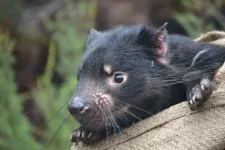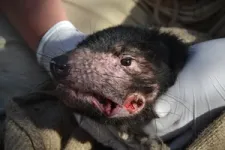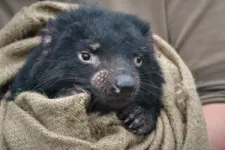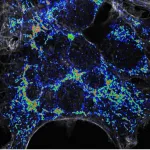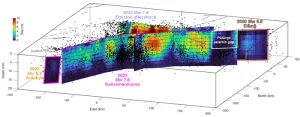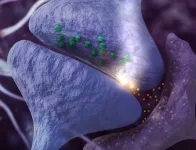(Press-News.org) PRESS RELEASE FROM THE UNIVERSITY OF CAMBRIDGE
EMBARGOED UNTIL 19:00 BST LONDON TIME/14:00 US EASTERN TIME THURSDAY, 20 APRIL 2023
Paper and photos available at: https://drive.google.com/drive/folders/1YaEEaTCCMRt85NXmCSpeO15YOrIRaXpO?usp=share_link
Transmissible cancers, which occur only rarely in the animal kingdom, are spread by the transfer of living cancer cells. In the case of Tasmanian devils, the cells are transferred through biting – a behaviour that is common in devils especially in fights over mates and food.
Tasmanian devils are susceptible to two fatal transmissible cancers called devil facial tumour 1 (DFT1) and devil facial tumour 2 (DFT2) that have caused rapid population decline in recent decades. The two cancers both manifest with disfiguring facial tumours.
In a new study, University of Cambridge researchers mapped the emergence and mutations of DFT1 and DFT2 and characterised these cancers’ ongoing evolution. The findings underline the continued threat that transmissible cancers pose to Tasmanian devils.
The results are published today in the journal Science.
“The incredible fact that Tasmanian devils have not one, but two, transmissible cancers, makes it possible to compare their evolution, and this gives us new insights into the key mechanisms involved,” said lead author Elizabeth Murchison, Professor of Comparative Oncology and Genetics at the Department of Veterinary Medicine, University of Cambridge.
“By looking at the mutations that have accumulated in these cancers’ DNA, we can trace the origins and evolution of these diseases. Our results show that the two cancers arose through similar processes and that both have striking signals of ongoing evolution. It is difficult to predict how this continued cancer evolution will impact devils.”
The researchers created an improved ‘reference genome’ – essentially a map of the entire DNA sequence – of the Tasmanian devil and compared this to DNA taken from 119 DFT1 and DFT2 tumours. DFT1 was first observed in 1996 in Tasmania’s northeast and is now widespread throughout Tasmania. DFT2, on the other hand, was first observed in 2014 and remains confined to a small area in Tasmania’s southeast. The scientists identified mutations in the tumours and used these to build ‘family trees’ of how the two cancers had each independently arisen and evolved over time.
By tracking mutations the researchers discovered that DFT2 acquired mutations about three times faster than DFT1. As mutations usually occur during cell division, the most likely explanation is that DFT2 is a faster growing cancer than DFT1, say the researchers, underlining the importance of DFT2 as a threat.
“DFT2 is still not widespread in the devil population, and very little is known about it. We were really startled to see just how quickly it was mutating, alerting us to what could be a very unpredictable threat to the devils in the long term,” said Maximilian Stammnitz, first author of the study.
The team found that DFT1 arose in the 1980s, up to 14 years before it was first observed, whereas DFT2 emerged between 2009 and 2012, only shortly before it was detected.
Mapping the mutations revealed that DFT1 underwent an explosive transmission event shortly after it emerged. This involved a single infected devil transmitting its tumour to at least six recipient devils.
DFT1 has now spread throughout almost the entire devil population and has recently been reported in the far northwest of Tasmania, one of the few remaining disease-free regions of the state.
Researchers also identified for the first time an instance of DFT1 transmission between a mother and the young in her pouch. Additionally, they found that the incubation period – the time between infection and the emergence of symptoms – can in some cases be a year or more. These findings have important implications for conservation scientists working to protect the species.
“I come from Tasmania and love Tasmanian devils – they have a special place in my heart,” said Murchison. “Transmissible cancers pose an unprecedented and unpredictable threat to Tasmanian devils. This research highlights the continuing importance of monitoring and conservation programmes. It also gives us new insights into the evolutionary mechanisms operating in cancer more broadly, including in human cancers.”
The research was funded by Wellcome, the Gates Cambridge Trust and Eric Guiler Tasmanian Devil Research Grants from the University of Tasmania Foundation.
ENDS.
Reference:
M. R. Stammnitz et al. The evolution of two transmissible cancers in Tasmanian devils, Science, DOI: 10.1126/science.abq6453
Contact details:
Charis Goodyear, University of Cambridge Charis.Goodyear@admin.cam.ac.uk
Elizabeth Murchison, University of Cambridge epm27@cam.ac.uk
About the University of Cambridge
The University of Cambridge is one of the world’s leading universities, with a rich history of radical thinking dating back to 1209. Its mission is to contribute to society through the pursuit of education, learning and research at the highest international levels of excellence.
Cambridge was second in the influential 2023 QS World University Rankings, the highest rated institution in the UK.
The University comprises 31 autonomous Colleges and over 100 departments, faculties and institutions. Its 20,000 students include around 9,000 international students from 147 countries. In 2022, 72.5% of its new undergraduate students were from state schools and more than 25% from economically disadvantaged backgrounds.
Cambridge research spans almost every discipline, from science, technology, engineering and medicine through to the arts, humanities and social sciences, with multi-disciplinary teams working to address major global challenges. In the Times Higher Education’s rankings based on the UK Research Excellence Framework, the University was rated as the highest scoring institution covering all the major disciplines.
The University sits at the heart of the ‘Cambridge cluster’, in which more than 5,200 knowledge-intensive firms employ more than 71,000 people and generate £19 billion in turnover. Cambridge has the highest number of patent applications per 100,000 residents in the UK.
www.cam.ac.uk
END
Evolution of two contagious cancers affecting Tasmanian devils underlines unpredictability of disease threat
Scientists have traced the family trees of two transmissible cancers that affect Tasmanian devils and have pinpointed mutations which may drive growth of deadly diseases
2023-04-20
ELSE PRESS RELEASES FROM THIS DATE:
A gene involved in Down syndrome puts the brakes on neurons' activity in mice, new study shows
2023-04-20
Researchers from the University of Michigan have found that an extra copy of a gene in Down syndrome patients causes improper development of neurons in mice.
The gene in question, called Down syndrome cell adhesion molecule, or DSCAM, is also implicated in other human neurological conditions, including autism spectrum disorders, bipolar disorder and intractable epilepsy.
The cause of Down syndrome is known to be an extra copy of chromosome 21, or trisomy 21. But because this ...
Cracking the case of mitochondrial repair and replacement in metabolic stress
2023-04-20
LA JOLLA (April 20, 2023)—Scientists often act as detectives, piecing together clues that alone may seem meaningless but together crack the case. Professor Reuben Shaw has spent nearly two decades piecing together such clues to understand the cellular response to metabolic stress, which occurs when cellular energy levels dip. Whether energy levels fall because the cell’s powerhouses (mitochondria) are failing or due to a lack of necessary energy-making supplies, the response is the same: get rid of the damaged mitochondria and create new ones.
Now, in a study published in Science on April 20, 2023, Shaw and team cracked ...
The climate crisis and biodiversity crisis can’t be approached as two separate things
2023-04-20
Human beings have massively changed the Earth system. Greenhouse-gas emissions produced by human activities have caused the global mean temperature to rise by more than 1.1 degrees Celsius compared to the preindustrial era. And every year, there are additional emissions of carbon dioxide, methane and other greenhouse gases, currently amounting to more than 55 gigatonnes of carbon dioxide equivalent. This unprecedented climate crisis has consequences for the entire planet – the distribution of precipitation ...
Economic growth alone is not enough to eliminate rabies
2023-04-20
Economic growth alone may not be enough to deliver the internationally agreed target to end human deaths from dog mediated rabies, according to new research from the University of Surrey. The study identifies that targeting vulnerable populations and improving responsible pet ownership are urgently needed to eradicate the deadly disease, which has strong associations with poverty.
In a landmark study, Surrey researchers investigated whether incidences of rabies are an inevitable consequence of poverty or whether other measures of development, such as healthcare access, can play a role in tackling this preventable disease.
Dr ...
PLOS Genetics to launch Microbial Section
2023-04-20
SAN FRANCISCO — PLOS today announced that PLOS Genetics is expanding the scope of its journal with a renamed section called Microbial Genetics. This section will replace the former Prokaryotic Genetics section to emphasize research on microbes more broadly with the aim to publish studies that use genetic approaches to provide insights into how bacteria as well as archaea and their phages/viruses, fungi (including yeasts and filamentous fungi), and protists function and interact with the biotic and abiotic world.
PLOS Genetics has an established presence in the fungal genetics community, but this ...
Moffitt researchers discover pathway critical for lymphoma development
2023-04-20
TAMPA, Fla. — MYC proteins are important regulators of cancer cell growth, proliferation and metabolism through their ability to increase the expression of proteins involved in these processes. Deregulation of MYC proteins occurs in more than half of all cancers and is associated with poor patient prognosis and outcomes. Numerous researchers have devoted significant efforts to try to target MYC proteins as a therapeutic approach to treat cancer. However, this has been extremely challenging to date, and other complementary strategies are being investigated.
In a new article in Blood Cancer Discovery, which was published simultaneously with a presentation ...
Water arsenic including in public water is linked to higher urinary arsenic totals among the U.S. population
2023-04-20
April 20, 2023-- A new study by researchers at Columbia University Mailman School of Public Health shows that water arsenic levels are linked to higher urinary arsenic among the U.S. population for users of both private wells and public water systems. The findings are published in the journal Environmental Research.
Long-term exposure to arsenic even at low and moderate levels can increase the risk of cancer and other types of chronic disease. While drinking water along with diet is a major source ...
UHN Researchers publish ground breaking clinical trial in lung transplantation
2023-04-20
(Toronto, April 20, 2023) Storing donor lungs for transplant at 10 degrees Celsius markedly increases the length of time the organ can live outside the body according to research led by a team of scientists at the Toronto Lung Transplant Program in the Ajmera Transplant Centre at the University Health Network (UHN).
The prospective multicenter, nonrandomized clinical trial study of 70 patients demonstrated that donor lungs remained healthy and viable for transplant up to four times longer compared ...
Turkey’s next quake: USC research shows where, how bad — but not ‘when’
2023-04-20
Researchers know a lot about Turkey’s next major earthquake. They can pinpoint the probable epicenter, estimate its strength and see the spatial footprint of where damage is most likely to occur.
They just can’t say when it will happen.
That’s the main takeaway from a new USC-led study that appears today (April 20) in Seismica.
Using remote sensing, USC geophysicist Sylvain Barbot and his fellow researchers documented the massive Feb. 6 quake that killed more than 50,000 people in Eastern Turkey and toppled more than 100,000 buildings.
Alarmingly, researchers found that a section of the fault remains unbroken and locked – a sign that the plates there ...
Astrocyte dysfunction causes cognitive decline
2023-04-20
People with dementia have protein build-up in astrocytes that may trigger abnormal antiviral activity and memory loss, according to a preclinical study by a team of Weill Cornell Medicine investigators.
Dysfunction in cells called neurons, which transmit messages throughout the brain, has long been the prime suspect in dementia-related cognitive deficits. But a new study, published in Science Advances on April 19, suggests that abnormal immune activity in non-neuronal brain cells called astrocytes is sufficient to cause cognitive deficits in dementia. The discovery could lead to new treatments that reduce excess immune activity in astrocytes and their detrimental effects on other brain ...
LAST 30 PRESS RELEASES:
Longest observation of an active solar region
Why nail-biting, procrastination and other self-sabotaging behaviors are rooted in survival instincts
Regional variations in mechanical properties of porcine leptomeninges
Artificial empathy in therapy and healthcare: advancements in interpersonal interaction technologies
Why some brains switch gears more efficiently than others
UVA’s Jundong Li wins ICDM’S 2025 Tao Li Award for data mining, machine learning
UVA’s low-power, high-performance computer power player Mircea Stan earns National Academy of Inventors fellowship
Not playing by the rules: USU researcher explores filamentous algae dynamics in rivers
Do our body clocks influence our risk of dementia?
Anthropologists offer new evidence of bipedalism in long-debated fossil discovery
Safer receipt paper from wood
Dosage-sensitive genes suggest no whole-genome duplications in ancestral angiosperm
First ancient human herpesvirus genomes document their deep history with humans
Why Some Bacteria Survive Antibiotics and How to Stop Them - New study reveals that bacteria can survive antibiotic treatment through two fundamentally different “shutdown modes”
UCLA study links scar healing to dangerous placenta condition
CHANGE-seq-BE finds off-target changes in the genome from base editors
The Journal of Nuclear Medicine Ahead-of-Print Tip Sheet: January 2, 2026
Delayed or absent first dose of measles, mumps, and rubella vaccination
Trends in US preterm birth rates by household income and race and ethnicity
Study identifies potential biomarker linked to progression and brain inflammation in multiple sclerosis
Many mothers in Norway do not show up for postnatal check-ups
Researchers want to find out why quick clay is so unstable
Superradiant spins show teamwork at the quantum scale
Cleveland Clinic Research links tumor bacteria to immunotherapy resistance in head and neck cancer
First Editorial of 2026: Resisting AI slop
Joint ground- and space-based observations reveal Saturn-mass rogue planet
Inheritable genetic variant offers protection against blood cancer risk and progression
Pigs settled Pacific islands alongside early human voyagers
A Coral reef’s daily pulse reshapes microbes in surrounding waters
EAST Tokamak experiments exceed plasma density limit, offering new approach to fusion ignition
[Press-News.org] Evolution of two contagious cancers affecting Tasmanian devils underlines unpredictability of disease threatScientists have traced the family trees of two transmissible cancers that affect Tasmanian devils and have pinpointed mutations which may drive growth of deadly diseases
